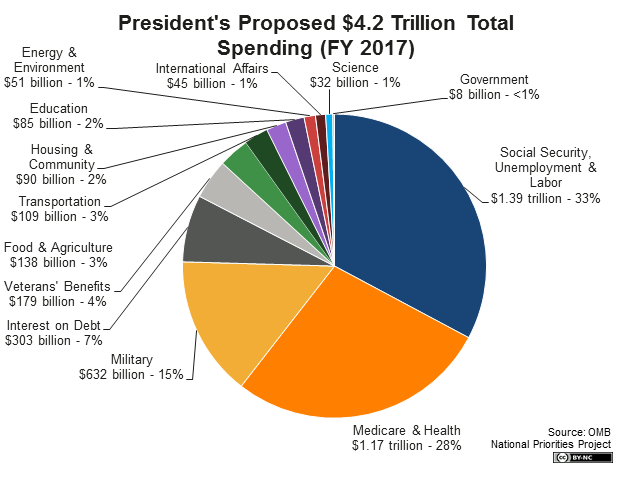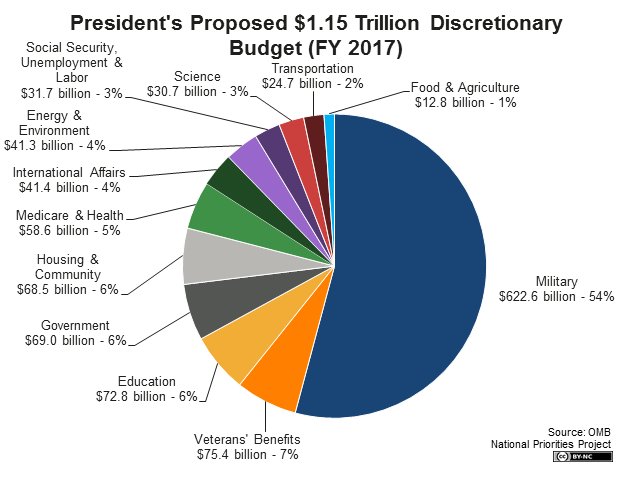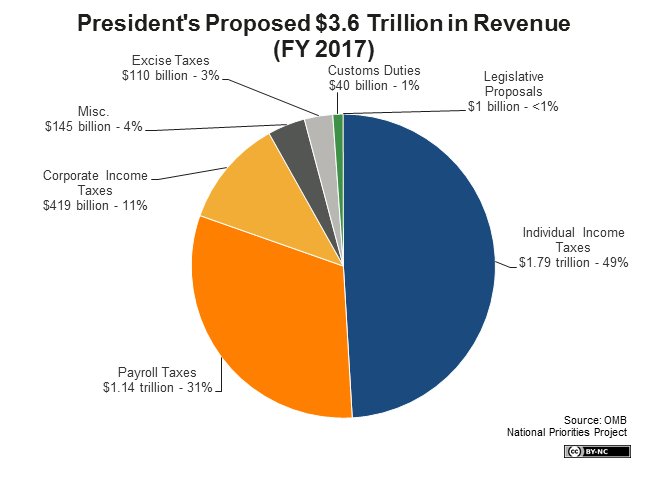President Obama Proposes 2017 Budget
Feb. 11, 2016 - Download PDF Version
New proposal calls for investment in domestic priorities but also prioritizes Pentagon spending and military force.
By: Jasmine Tucker and Lindsay Koshgarian
Americans rightly expect certain things of our government: clean, safe drinking water and air, an education system that works, and a system that allows anyone to succeed.
But those priorities aren’t always what we see if we look at our federal budget. Too often, we see a budget that benefits special interests at the expense of ordinary people. And more than half of discretionary spending is reserved for the Pentagon, war, and related costs. What’s more: about half of Pentagon spending has been captured by for-profit contractors. Meanwhile, proposals that would benefit Americans, like free community college, receive little or no consideration by our current Congress.
President Obama’s final budget proposal calls for increased investment in education, the fight against climate change, and family-friendly tax policies, all of which enjoy broad popular support. However, it also calls for continued windfalls for the Pentagon that will benefit for-profit contractors without adding to our security.
Here are highlights of what the new budget proposal contains:
Total Spending
The president’s proposal calls for $4.2 trillion in federal government spending in 2017, representing a four percent increase over 2016 total spending. Of that, $1.15 trillion is for the discretionary spending budget that Congress legislates each year, and nearly $2.8 billion would be for mandatory spending authorized by existing law.
Compared to 2016, discretionary spending would decrease in every category except veterans’ benefits and labor – including education, science and international affairs. Mandatory spending would increase by more than five percent over 2016, with the biggest increases in Social Security, transportation, and Medicare.

Of the discretionary spending total, $622.6 billion, or 54 percent, would be set aside for the Pentagon, nuclear weapons and related items. The next biggest category of discretionary spending would be veterans’ benefits, receiving an additional $75.4 billion. These two categories total nearly 61 percent of the total discretionary budget. The remaining 39 percent would fund education, housing and community programs, science, the environment, and more.

Economic Inequality and Opportunity
The budget includes proposals that would explicitly create economic opportunity, or help to ameliorate the effects of growing inequality, including:
- Nearly $6 billion in new funding to connect young, disconnected Americans to their first job. The program would help nearly one million young people get summer jobs, and an additional 150,000 young people to find employment for up to a year;
- An indefinite expansion of the Affordable Care Act’s three years of full federal support for Medicaid expansion by states. Nineteen states have chosen not to expand Medicaid coverage under the Affordable Care Act. The cost of the proposal would depend on how many of these states choose to extend help to struggling Americans;
- A clean transportation package totaling $32 billion per year over ten years that would create hundreds of thousands of middle-class jobs in an economy that still doesn’t provide enough opportunities for good-paying work.
Education
A strong education system is a clear prerequisite to a fair economy with equal opportunity for all. Americans consistently say that more investment in education is among their top priorities for our government.
The president’s budget proposal includes a number of targeted proposals for increasing education funding, including:
- Two free years of community college, a federal-state initiative that would cost the federal government $61 billion over ten years – which the current Congress failed to take up last year.
- Increasing Pell grant funding by $2 billion, in stark contrast to congressional proposals to freeze or cut funding to the program for the lowest-income college students.
- Continuing support for the president’s signature Preschool for All program, a federal-state partnership that provides preschool support for the lowest income four-year olds.
- Modest increases in funding to other federal preschool programs, including a $434 million increase for Head Start over 2016 figures, to a total of $9.6 billion in 2017;
- $4 billion over three years in new Science, Technology, Engineering, and Math (STEM) funding for K-12 education.
Climate Change
The budget proposes to double clean energy research and development to a level of $12.8 billion by 2021.
The proposed $32 billion per year to improve our nation’s transportation systems is also intended as a climate change measure, and would include investments such as:
- Providing $10 billion per year for transit improvements;
- A $7 billion per year investment in high speed rail;
- A $2 billion per year investment in cleaner vehicles and aircraft.
Pentagon and Related Spending
The budget maintains the status quo, with more than half of discretionary funding (the funding Congress allocates each year during its budget process) reserved for the Pentagon and spending on nuclear weapons and related items. Total Pentagon and related spending in the request amounts to nearly $623 billion, including the Pentagon budget, nuclear weapons and aid to foreign militaries. The budget provides $583 billion for the Pentagon alone in 2017, a $2 billion increase over 2016.
Pentagon funding of $583 billion includes:
- A $59 billion 2017 Pentagon slush fund, or Overseas Contingency Operations (OCO) funding – a fund that began as an Iraq and Afghanistan war fund and has since morphed into a Pentagon petty cash jar, and which permits the Pentagon to bust through legislated budget caps;
- Just $7.5 billion, less than two percent of the Pentagon’s total budget, for fighting ISIS, making clear that even real terrorist threats are often cynically used to secure billions in unrelated Pentagon funding;
- Quadrupled funding, or $3.4 billion, for the European Reassurance Initiative, recommitting the United States to military involvement in a conflict where our ability to make a positive difference is highly questionable.
The Pentagon budget is more than ten times the budget allocated for diplomacy under the Department of State, which is $52.7 billion in 2017. There are often effective alternatives to war, but we too often do not employ them. Compared to $7.5 billion for military efforts against ISIS, the budget provides just $4 billion for dedicated diplomacy and humanitarian relief around the region.
Meanwhile, in addition to the $583 billion Pentagon budget, the president’s request includes:
- $19 billion for nuclear weapons and related activities;
- $13 billion for foreign military assistance;
- $8 billion for additional “defense-related activities.”
Unemployment Insurance
The president’s budget proposes reforms to modernize the Unemployment Insurance (UI) program so that more workers are covered and for longer periods of time.
Proposals include:
- Requiring that each state provide a minimum of 26 weeks of state benefits (9 states currently provide less);
- Expanding benefits to cover millions of part-time workers and those who must leave a job for compelling family reasons;
- Expanding UI’s federal extended benefits program to provide up to 52 weeks of additional federal benefits for states with higher than average unemployment rates.
Social Security and Medicare
As in 2016, the president’s 2017 proposal would close loopholes that allow some high-income individuals to avoid Medicare and Social Security payroll taxes, which could provide as much as $10 billion more in revenue per year by the end of the decade.
The budget also proposes certain reforms to the Medicare program that would extend the solvency of Medicare Part A - the Hospital Insurance trust fund - by an additional 15 years. The program is currently fully funded until 2030. The president’s plan would lower prescription drug costs under Medicare Part D and introduce a co-payment for beneficiaries who receive home health care services, among other reforms.
Taxes and Revenues
The president’s budget proposal projects $3.6 trillion in total tax revenue in fiscal year 2017, and includes proposals that focus on raising additional revenue and increasing fairness and transparency in the tax system. Many of these would be very popular among Americans, who believe the wealthy and corporations don’t pay enough in taxes.

The proposal would raise $955 billion over ten years by closing certain loopholes for wealthy taxpayers. For example, it would:
- Raise the top tax rate on capital gains (currently 20 percent) to equal the rate under President Reagan (28 percent) and close certain tax loopholes on individual investments;
- Limit the value of certain deductions to 28 percent;
- Close the “carried interest” loophole, among other tax breaks;
- Implement the “Buffet Rule,” ensuring that the wealthiest Americans pay at least 30 percent in income taxes even after they’ve availed themselves of the numerous tax loopholes available to them.
These reforms would make taxation on the wealthy more in line with the taxation of income earned by lower- and middle-income Americans.
The president also proposed measures to require corporations to pay their fair share. In combination these measures would increase corporate tax revenues from $298 billion in 2016 to nearly $419 billion in 2017. These measures include:
- A new fee for large financial institutions – roughly 100 firms with assets of more than $50 billion – that would discourage excessive risk-taking and raise $111 billion over ten years in new revenue.
- Requiring companies to pay taxes on income earned abroad, which would prevent U.S. companies from “inverting,” a maneuver where American corporations arrange to be purchased by smaller overseas corporations to avoid paying U.S. taxes.
The plan wouldn’t only raise more revenue. It would also use the tax code to combat economic inequality directly, by building upon improvements made to the Earned Income Tax Credit (EITC) under the American Recovery and Reinvestment Act (ARRA) to expand EITC benefits for childless workers. It would increase the size of the credit and provide the credit to more workers based on income and age.
Budget Deficit
The president’s budget proposal would run a deficit of $503 billion in fiscal year 2017, down from $616 billion in 2016. The plan would achieve $2.9 trillion in deficit reduction over ten years from various health, immigration, and tax reforms, including $955 billion over ten years from closing certain loopholes for wealthy taxpayers.
As a share of the economy, the deficit is projected to be 2.6 percent of the economy in 2017, down from a high of 10 percent in 2009 following the Great Recession. The president proposes to limit deficits to less than 3 percent of the economy over the next ten years, which is on par with recent history: over the last 50 years, budget deficits have averaged 2.9 percent of the economy.
What Is the President’s Budget Request?
Federal law requires that the president submit a budget proposal to Congress every February, which serves as a starting point for negotiations in Congress. The proposal begins the annual federal budget process that creates the budget for the coming fiscal year, which begins on Oct. 1. For more on who decides the federal budget, see Federal Budget 101.
Why Does the President’s Budget Matter?
Though the budget ultimately enacted by Congress may look very different from the budget request released by the president, the president’s budget is important. It’s the president’s vision for the country in fiscal year 2017 and beyond, and it reflects input and spending requests from every federal agency. At a time of conflict over federal spending, the president’s budget is largely a political document – but an important one, because it shows the president’s priorities in detail. It also serves as a benchmark against which all subsequent spending legislation will be measured.